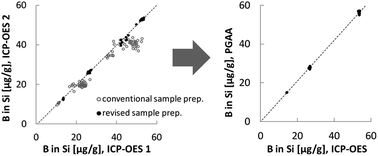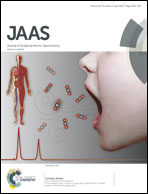Boron speciation in acid digests of metallurgical grade silicon reveals problem for accurate boron quantification by inductively coupled plasma – optical emission spectroscopy
Abstract
The boron (B) content is a major parameter rigorously monitored during production of silicon (Si) for different industrial applications, since it is crucial for defining the electronic properties of the final product. During the validation of a newly acquired inductively coupled plasma-optical emission spectrometer (ICP-OES) in an industrial analytical laboratory a significant bias between results of the established and the new instrument was observed. During investigation of the reasons for the observed bias it was found that B in acidic Si digests, prepared using HNO3 and HF, is present as at least two different molecular species. One of them is easily hydrolyzed during acid digestion and was identified as boric acid (B(OH)3) by HPLC-inductively coupled plasma-mass spectrometry (HPLC-ICP-MS). The other B species-referred to as unknown B species- is stable under strongly acidic conditions, sensitive to oxidation by H2O2 and cannot be generated during sample digestion from isotopically labelled 10B(OH)3. Indications for the unknown B species were found in all investigated metallurgical grade Si samples and identified as the source of significant measurement error in solution nebulisation ICP-OES based B quantifications. Oxidation of the unknown B species with a B/Si stoichiometry of approximately 1/10 with H2O2 significantly increased the B concentrations determined by ICP-OES and results agreed well with prompt gamma activation analysis (PGAA) measurements.


 Please wait while we load your content...
Please wait while we load your content...